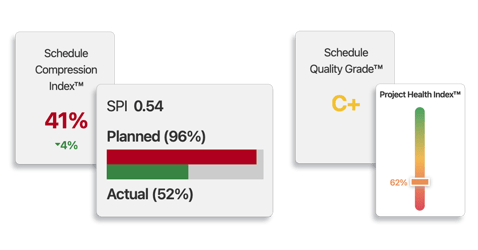Resolutions are about breaking cycles, whether in personal health, communication, habits, or relationships. But resolutions aren’t limited to personal growth; they are also an opportunity to break cycles of inefficiency, miscommunication, and mismanagement in our professional lives.
In construction project management, that means embracing smarter ways of working – leveraging technology, refining processes, and asking better questions about how we deliver projects.
This year, let’s focus on key areas like risk mitigation, data-driven decision-making, and reducing stress to create a more streamlined and successful approach to project controls. Wherever you are on your journey, these resolutions can help you take meaningful steps toward smart project management in 2025.
1. Use Schedules the Right Way
Too many teams treat the schedule as a document you update for the sake of reporting. It’s not. A schedule is a tool—it should drive how you manage the project every day. Here’s how to get it working for you:
- Build schedules with logic. That means every activity (except the first and last) has a predecessor and successor.
- Go beyond tracking. Use the schedule to predict problems before they become delays.
- Keep it simple. If your schedule is a 50-page Gantt chart, nobody will follow it. Make it clear enough that even the least tech-savvy team member can understand what’s happening.
When your schedule becomes a shared playbook instead of a complex document, managing projects gets easier.
2. Let Data Drive Accountability
Accountability isn’t about pointing fingers – it’s about making sure everyone has the same understanding of the project. Data is the tool to make that happen. Use it to:
- Spot potential risks before they become real problems.
- Bring objective numbers into the conversation to avoid “he said, she said” debates.
- Make sure everyone has access to the same insights – transparency builds trust and keeps teams aligned.
When everyone can see the same data, you spend less time arguing and more time-solving problems.
3. Reduce Risk with Smarter Scheduling
A schedule isn’t just a roadmap—it’s your most powerful tool for managing risk. From budgets to safety to stakeholder relationships, it connects all the critical elements of a project. When built and maintained properly, a good schedule protects you from the chaos of last-minute surprises.
- Connect your schedule to cash flow and billing cycles to keep the budget on track.
- Use the schedule to flag high-risk phases of the project and avoid stacking tasks that lead to long hours or rushed work.
- Leverage tools like schedule quality checkers to catch errors, ensure accuracy, and proactively identify potential delays before they become bigger problems.
A strong schedule management process is the backbone of enterprise risk management, connecting quality, safety, cost, and relationships into a single, actionable framework. Plan ahead, and you’ll avoid the unnecessary headaches that derail so many projects.
4. Automate What You Can
Nobody has time to manually crunch numbers or sort through endless schedule updates. The right tools can handle the heavy lifting and free up your team to focus on solving real problems.
- Automate schedule analysis to save hours of manual effort and catch errors faster.
- Use tools that are intuitive enough for non-schedulers so everyone can contribute.
- Cut out the noise by focusing on the issues that truly matter.
When you automate the repetitive stuff, you can spend your energy on things that move the needle.
5. Make Real-Time Decisions with Real-Time Data
Reacting to yesterday’s problems won’t help you finish a project on time. Frequent updates and real-time data help you stay ahead of the curve.
- Keep your schedule current so you can make decisions based on what’s happening now, not what happened last month.
- Blend gut instinct with data. Numbers tell a story—use both to make smart calls.
- Work from a shared set of numbers so everyone is pulling in the same direction.
Data doesn’t just measure progress – it helps you course-correct when it matters most. 
6. Stay Ahead of End-of-Project Stress
The last 10% of a project shouldn’t feel like a sprint. The crunch happens because of poor planning earlier in the process. Avoid it by:
- Regularly updating schedules and addressing slippage early.
- Giving clients and teams visibility into progress—no surprises.
- Keeping alignment with clear communication and check-ins throughout the project.
Finishing strong starts with staying steady from day one.
7. Invest in Your Team’s Well-Being
You can’t finish a project without your team, so it’s worth making their well-being a priority. Better planning means less stress, better retention, and stronger performance.
- Reduce overtime with smarter scheduling and better resource management.
- Build confidence by setting clear goals and giving teams the tools they need to succeed.
- Remove unnecessary chaos to create a work environment people actually enjoy.
Happy teams build better projects.
Start the Year with Smart Project Management
2025 doesn’t have to be a repeat of the same old challenges. By focusing on better schedules, cleaner data, and smarter decisions, you’ll set your projects—and your team—up for success. If you’re ready to leave inefficiencies behind, let SmartPM help you make this the year you work smarter, not harder.
If any of these resolutions sound hard to tackle or you’re not sure where to start, we’re here to help. We’ve supported hundreds of customers through the journey to better project management/project controls and we can support you too!


